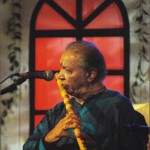Pandit Hariprasad Chaurasia performs at Dhaka Club
From The Daily Star
 According to mythology, ‘bansuri’ (South Asian transverse alto flute) is intimately linked to the love story of Krishna and Radha. Legends narrate how the tunes of bansuri would drive the women of Braj into a frenzy.
According to mythology, ‘bansuri’ (South Asian transverse alto flute) is intimately linked to the love story of Krishna and Radha. Legends narrate how the tunes of bansuri would drive the women of Braj into a frenzy.
For eons bansuri has been very popular in folk music. Its introduction in Indian classical music has been rather recent, however, and the late Pandit Pannalal Ghosh has been widely recognised for this achievement.
Pandit Hariprasad Chaurasia further enhanced the bansuri playing style with his innovative techniques and gave the instrument a higher status.
The Indian master musician performed live at Dhaka Club on October 23. In association with the event management group Web Entertainment Ltd, Dhaka Club organised the programme.
The President of Dhaka Club Ltd, Sadat Hossain Salim, said, “Dhaka Club strongly believes in providing patronage to classical music. Renowned artistes of the sub-continent like Mehdi Hassan, Hemanta Mukhopadhyay, Ustad Ghulam Ali and Ustad Amjad Ali Khan have performed here. Continuing with that tradition, Dhaka Club invited Pandit Chaurasia to grace us with his music.”
Pandit Hariprasad Chaurasia was born in Allahabad, India, in 1938. Chaurasia surprisingly does not come from a long lineage of flutists. His father was a famous wrestler who had aspirations of his son following in his footsteps. Chaurasia has said that he takes advantage of his wrestling training as it gives him immense stamina and lung power that are the hallmarks of his flute playing.
When he was just 19, he got a job playing for All India Radio, Cuttack, Orissa, and within five years he was transferred to their headquarters in Bombay (now Mumbai). There he got the additional exposure of performing in one of India’s cultural centres and also studied with Annapurna Devi, daughter of Ustad Allauddin Khan.
There he established the creative peak of his career, developing a style that was respectful of tradition, yet demonstrated innovation. In 1992, he was awarded the Padma Bhushan and in 2000, the Padma Vibhushan. Chaurasia has also composed music for a number of Indian films and has performed throughout the world along with renowned musicians, including Yehudi Menuhin and Jean Pierre Rampal. Currently he heads the World Music Department at the Rotterdam Music Conservatory.
As the Pandit began around 9:30 pm, the hustle and bustle of the busy Shahbagh intersection — in particular, the honking buses — was clearly a nuisance. Chaurasia’s bansuri was potent enough to take flute enthusiasts to another realm. However, the relentless ringing of cell phones and people in the audience chatting during the performance were absolutely regrettable. It’s an affront to an artiste of Chaurasia’s stature as well as those who went there to enjoy a superlative act.
Starting with Raaga Bageshri (usually played late at night, articulating the emotion of a woman waiting to be reunited with her beloved), the Pandit continued with dhrupad, Raaga Misra and more. Duration of each composition was approximately 15 minutes. A reputed classical musician is capable of playing one raaga throughout the whole night, but as it can be assumed, the Pandit chose to give the audience samples of the compositions.
The highlight of the performance was the versatility of bansuri. It easily produces all basic elements of Hindustani music, such as ‘meend’ (glide) and ‘gamak’ (variation of pitch). Bansuri is a simple instrument. Unlike string instruments, it does not need constant tuning.
However, as Pandit Chaurasia puts it, “it is Krishna’s instrument and the Lord has made it deceptively simple.”




















